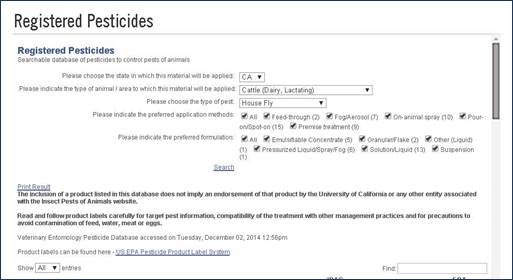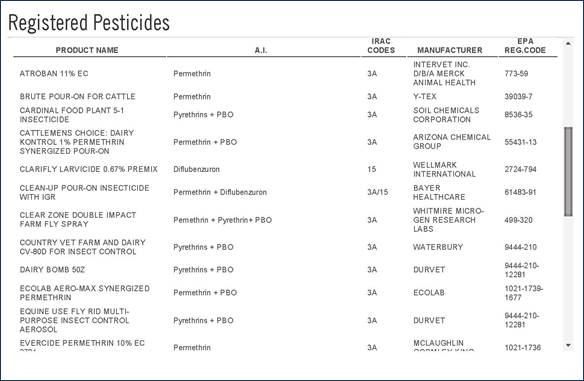 |
June 2015
|
June 2015 // Volume 53 // Number 3 // Tools of the Trade // v53-3tt7
VetPestX: Finally! An Online, Searchable, Pesticide Label Database Just for Pests of Animals
Abstract
Almost all online pesticide databases contain crop-specific product labels; very few include products labeled for animal use. A single online location for veterinary pesticide labels was needed. Led by Alec Gerry of the University of California at Riverside (UCR), veterinary entomologists from California, Washington, New Mexico, and Oklahoma contributed information on animal pesticide products registered in five western states (CA, WA, OR, ID, NM) and OK to a new, online, searchable, veterinary pesticide labels database named VetPestX, developed and maintained on UC Riverside's website. Animal producers and owners requesting pesticide information to manage pests are now routinely directed to VetPestX.
Introduction
Extension professionals with animal pest management expertise are frequently queried for information on pesticides used to control pests of animals. These requests are common because clientele may (1) have difficulty navigating state-operated pesticide registration databases, (2) want to know about new products or technologies they should be considering, and/or (3) be interested in managing pests using the most effective and environmentally sensitive materials that may be incorporated into existing integrated pest management (IPM) programs. Animal managers need to know what products can be used both effectively and safely against pests of animals. This also provides a window of opportunity to educate these managers on IPM practices and technologies applicable to their operations.
Many online pesticide databases are available for use by the public, but they focus primarily on agronomic crop pesticide labels, with less attention given to livestock/poultry/pet product labels. Two recent examples of electronic databases developed for crop-specific management that include pesticide information are: (1) the CD-based IPM module for small grains (Resel & Arnold, 2010) and (2) the turfgrass management smart-phone application (McCullough, Waltz, Hudson, & Martinez-Espinoza, 2011). Veterinary pesticide product information is scattered widely on the Internet and is not easy for animal managers or Extension professionals to access.
Recently, in Baton Rouge, Louisiana, a group of livestock entomology experts from across the country gathered to develop a 5-year proposal for multi-state collaboration on research projects fitting under the umbrella title of "Fly Management in Animal Agriculture Systems and Impacts on Animal Health and Food Safety" (Roeder, 2013). A new requirement for this 5-year cycle was an Extension objective, Community and Stakeholder Engagement. A key component of this objective was to compile a database of registered pesticides used in animal production. With product manufacturers' help and support, we would create an online database for all pesticides registered for use in animal agriculture in the United States. In so doing, we would bridge a gap between industry and Extension by providing industry with a mechanism to self-report their current products, state registrations, and label revisions, while ensuring oversight of the process by university Extension personnel.
Database Development and Use
In early 2014, Gerry initiated the development of the database on his University of California webpage and later received funding from the Western Integrated Pest Management Center (http://westernipm.org/) to support the development of a user interface for Web queries. Data from the Microsoft® Access Database were exported as Microsoft® Excel files and uploaded to the search database via an Application Programming Interface (API). The database is now accessible at http://veterinaryentomology.ucr.edu/vet_pesticides.html. Each product record in the database is linked with its active ingredient(s), IRAC code, manufacturer, and EPA registration code. IRAC (Insecticide Resistance Action Committee) code refers to the active ingredient's mode of action (http://www.irac-online.org/eClassification/) and can help users determine how to properly rotate pesticides to reduce resistance development.
Initially, the database contained only California products. Products included those registered for use on cattle, horses, sheep, goats, swine, poultry, dogs, and cats, and those for use on/around animal housing. Ferguson contributed product labels from Washington and Oregon by comparing California product names with those found on PICOL (Pesticide Information Center Online, http://picol.cahe.wsu.edu/labels/Labels.php). Ferguson also contributed product labels from Idaho by cross-checking Idaho's pesticide label database at http://www.kellysolutions.com/ID/. Gerry presented the prototype to livestock entomologists at the 2014 Livestock Insect Workers Conference in June (Gerry & Ferguson, 2014), and invited Extension personnel from other states to participate in the development of the database. In addition, Gerry met with industry representatives present at the conference to garner support for the maintenance of the online database. Talley contributed Oklahoma product registrations by checking the state's label database at http://www.kellysolutions.com/ok/pesticideindex.htm, and Smythe provided product labels from New Mexico's state database at https://nmag.nmsu.edu/USAPlants/ProductRegFSA/BrandSearch.aspx.
To query the database, a user would first choose their state, the host animal or animal usage area to be treated, and the type of pest. In the example illustrated in Figure 1, "California," "lactating dairy cattle," and "house fly" were chosen. Users may then choose any or all application methods and any or all formulation types. In the example, "All" was chosen for both. Clicking on "Search" executes the query and returns all products currently registered in California for use on lactating dairy cattle for control of house flies (Figure 2). Users may choose to print the list of product names by clicking on "Print Result" (Figure 1). If desired, users may search for product labels by clicking on "US EPA Pesticide Product Label System" (Figure 1).
Figure 1.
Initial Queries That Drive the User's Search for Product Names

Figure 2.
Partial Product List Returned From a Search of California Products Registered For Use on Lactating Dairy Cattle Against House Flies

Impacts and Future Plans
The unique veterinary pesticide labels database is easy to access, use, update, and maintain. Animal producers and owners requesting pesticide information to manage pests (via email, Ask an Expert [part of eXtension], phone calls, etc.) are now routinely directed to this website. The veterinary labels database was highlighted in the September 2014 issue of the Western Front, an e-newsletter of the Western IPM Center (http://www.icontact-archive.com/GRXUtzWNofP2xXJ2hQvOa0_o29OKaRFR?w=3 ). The database has also been featured in newsletters and blogs of Extension personnel throughout the western United States and at New Mexico State University's showcase fair in Las Cruces, New Mexico (Nuñez, Gerry, & Smythe, 2014).
We have given the database a name—VetPestX—to reflect its scope and intended use (the "X" is shorthand for Extension). We plan to add labels from additional states to work toward the ultimate goal of including product labels from all 50 states. We will install a mechanism on the website to elicit feedback from database users, which will help guide our strategies for improving VetPestX. Additional grant funding will be sought for the development of a smart-phone application for VetPestX, similar to those created by Beckerman and Sadof (2013) and McCullough et al. (2011).
Acknowledgements
Funding for online setup of the veterinary labels database was provided by a Special Issues Project Grant from the USDA-NIFA Western Integrated Pest Management Center. Support for hosting of website and database is provided by the University of California, Riverside. Trade names have been used to simplify explanation of information; no endorsement is intended.
References
Beckerman, J. L., & Sadof, C. S. (2013). Caught with your plants down? There's an app for that! Journal of Extension [On-line], 51(2) Article 2TOT3. Available at: http://www.joe.org/joe/2013april/tt3.php
Gerry, A. C., & Ferguson, H. (2014). Publicly accessible, query-driven database of registered pesticides for management of animal ectoparasites. Presentation at 58th Annual Livestock Insect Workers Conference, June 22-25, San Diego, CA.
McCullough, P. E., Waltz, F. C. Jr., Hudson, W., & Martinez-Espinoza, A. D. (2011). Turfgrass management at your fingertips: Information delivered through "smart" phone technology. 49(3). Article 3TOT10. Available at: http://www.joe.org/joe/2011june/tt10.php
Nuñez, S., Gerry, A., & Smythe, B. (2014). Query-driven database of registered pesticides for management of animal ectoparasites in New Mexico. Poster presented at the New Mexico State University Research and Creative Activities Fair, Las Cruces, NM.
Resel, E., & Arnold, S. (2010). Electronic integrated pest management program: An educational resource for Extension and agricultural producers. 48(6) Article 6IAW2. Available at: http://www.joe.org/joe/2010december/iw2.php
Roeder, R. (2013). Fly Management in Animal Agriculture Systems and Impacts on Animal Health and Food Safety. USDA-NIFA Multistate Research Project S1060. Retrieved from: http://nimss.umd.edu/lgu_v2/homepages/home.cfm?trackID=14976




